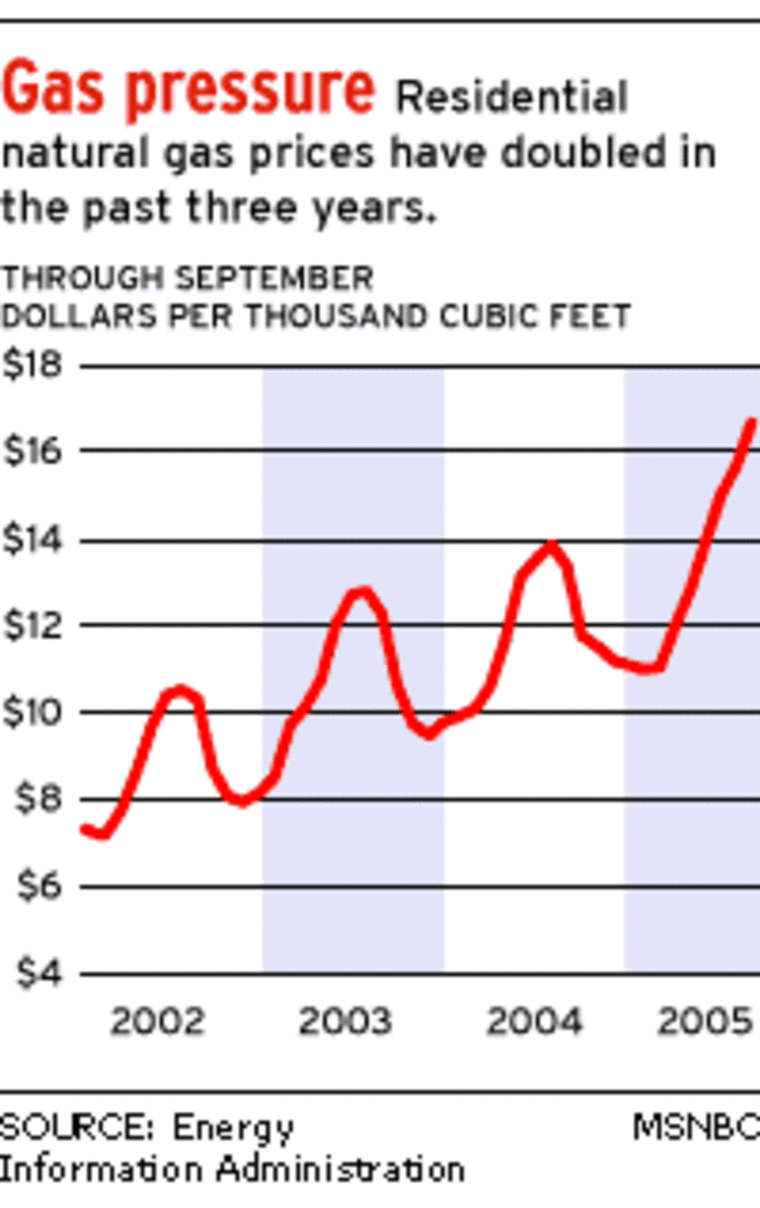As anyone who heats their home with natural gas knows, recent price increases are beginning to make gasoline look downright cheap. As demand shows no signs of slowing, natural gas producers are scrambling to bring more product to market.
To ease the crunch, dozens of new projects are under way around the world to produce and ship more liquefied natural gas, but those will take years to complete. In the meantime, ConocoPhillips’ bid for gas producer Burlington Resources is a $35 billion bet that high prices are here to stay.
No one knows just how high prices will go this winter. Last month, analysts at brokerage firm Raymond James told clients cold weather or supply interruptions could push natural gas as high as $20 per thousand cubic feet. But if supplies hold up and the weather remains mild, gas prices could be near their peak. (Prices typically fall in late winter as temperatures begin to rise and demand starts to ease.) Prices have been volatile this fall but have not budged much since reaching their highs in September.
In announcing the company’s bid for Burlington Resources, ConocoPhillips CEO Jim Mulva said he expects gas prices to fall. But he said they would remain high enough to make the deal profitable.

Natural gas prices have been rising for a number of reasons, sending consumers' energy bills soaring. Demand has grown along with the economy. Additionally, new electric power plants are using more of the fuel because it burns more cleanly than coal and other alternatives. Higher oil prices also have brought increased demand from industrial users that can switch from oil to gas.
U.S. suppliers have been struggling to keep up. Despite a record pace of drilling to produce more, natural gas production continues to fall because most of the best domestic gas fields already have been tapped. This fall, production was also hit hard by back-to-back hurricanes that shut down some operations in the Gulf of Mexico for months. As of this week, a quarter of all Gulf production capacity remains offline, and the total gas lost to the shutdowns amounts to about 14 percent of annual Gulf production, according to the U.S. Minerals Management Service.
Natural gas suppliers have been trying to make up the difference with imports, most of which come by pipeline from Canada. But much of Canada’s available output has already been tapped. So boosting imports further means turning to liquefied natural gas, created by pressurizing and cooling gas so it can be shipped by tanker.
That is where the current bottleneck is most severe: There aren’t enough LNG import terminals to make up for the shortfall in supplies. The Energy Information Administration estimates that less than 1 percent of U.S. natural gas demand will be met by LNG in 2005. Much of the available natural gas from other countries is being sent to Europe, where prices are even higher.
To get through the winter, U.S. natural gas suppliers have stockpiled some 3 trillion cubic feet. That’s about average for the past five winters, but 5 percent lower than this time last year, according to the EIA.
So predicting natural gas prices for the rest of the heating season is largely a matter of forecasting the weather. Colder-than-normal weather will squeeze gas supplies further. Even a return to average temperatures — after last year’s relatively mild weather — will send total home heating bills up nearly 50 percent for homeowners who use gas, according to the EIA.
Cold weather isn’t the only wild card. Earlier this year, problems at LNG production sites in Nigeria, Australia and Egypt sent gas prices rising; with markets already tight, any future production bottlenecks could boost prices again.
And like pump prices the price you pay for natural gas depends a lot on where you live. Much of the difference is the result of transportation costs: If you’re in a region of the country where natural gas is produced or live near a major pipeline you’ll pay less than customers where shipping costs are higher.
With domestic production falling, expanding supplies means greater reliance on LNG. Dozens of LNG production facilities are in the works around the world. But import terminals are in short supply.
In New England, for example, nearly 20 percent of demand is met with LNG imports shipped to a single terminal in Everett, Mass. At least seven new terminals have been proposed in coastal communities from Connecticut to Maine, but only one — in Fall River, Mass. — has won federal approval. Other projects have faced strong local opposition.
To try to ease the bottleneck, this year’s energy bill strengthened the power of the Federal Energy Regulatory Commission to approve new terminals. But it remains to be seen how much those added powers will speed the approval process where local opposition remains strong.
Even if those projects were approved quickly, it would be years before they would be able to help ease the natural gas squeeze. The Energy Department Monday forecast that LNG will make up only 8 percent of U.S. gas imports by 2010 (down from last year’s estimate of 10 percent), rising to 14 percent by 2020 (down from its previous estimate of 18 percent).